Underwood Typewriter Company
The Underwood Typewriter Company was a manufacturer of typewriters headquartered in New York City, New York. Underwood produced what is considered the first widely successful, modern typewriter. By 1939, Underwood had produced five million machines.[2]
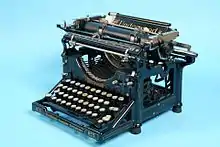 | |
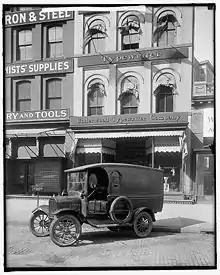 Exterior of the Underwood Typewriter Company with vehicle outside, circa 1905-45 | |
| Type | Private company |
|---|---|
| Industry | Business machines |
| Founded | 1895 |
| Founder | John T. Underwood |
| Defunct | Acquired by Olivetti (1959)[1] |
| Headquarters | , United States |
Key people | Franz X. Wagner, "Front strike" Inventor John T. Underwood, Namesake/founder |
| Products | Typewriters |
History

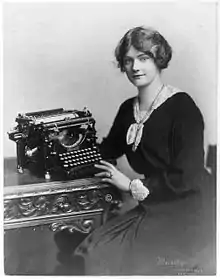
From 1874, the Underwood family made typewriter ribbon and carbon paper, and were among a number of firms who produced these goods for Remington. When Remington decided to start producing ribbons themselves, the Underwoods opted to manufacture typewriters.
The original Underwood typewriter was invented by German-American Franz Xaver Wagner, who showed it to entrepreneur John Thomas Underwood. Underwood supported Wagner and bought the company, recognising the importance of the machine. Underwood Number Ones and Number Twos, made between 1896 and 1900, had "Wagner Typewriter Co." printed on the back.
The Underwood Number 5 launched in 1900 has been described as "the first truly modern typewriter". Two million had been sold by the early 1920s, and its sales “were equal in quantity to all of the other firms in the typewriter industry combined”.[3] When the company was in its heyday as the worlds' largest typewriter manufacturer, its factory at Hartford, Connecticut was turning out typewriters at the rate of one each minute.
Underwood started adding addition and subtraction devices to their typewriters in about 1910.
Philip Dakin Wagoner was appointed president of the Elliott-Fisher Company after World War 1 (1914-1918). Elliott-Fisher became the parent of the Underwood Typewriter Company and the Sundstrand Adding Machine Co. In 1927 Wagoner reorganized the company into Underwood-Elliott-Fisher, which later became the Underwood Corporation.[4] The reorganization was completed in December 1927.[5] John Thomas Underwood was elected chairman and Wagoner president of Underwood Elliott-Fisher.[6]
In the years before World War II, Underwood built the worlds' largest typewriter in an attempt to promote itself. The typewriter was on display at Garden Pier in Atlantic City, New Jersey, for several years and attracted large crowds. Often, Underwood would have a young woman sitting on each of the large keys. The enormous typewriter was scrapped for metal when the war started.[7]
During World War 2, Underwood produced M1 carbines. Approximately 540,000 M1 carbines were produced from late 1942 to May of 1944. Underwood also produced M1 carbine barrels for the US government. Under the Free Issue Barrel Program, barrels were sent to other prime manufacturers who did not possess the machines to make barrels. It is thought that they made about 1 million barrels from late 1942 to late 1944. During the post-war period they were one of two civilian companies who were awarded a contract to refurbish M1 carbines. They were first to produce stamped and brazed parts by producing trigger housings and front sights reducing time and machines for complex work during milling operations.
In 1945 Wagoner was elected chairman of the board of Underwood, and Leon C. Stowell was elected president. Wagoner remained chief executive.[8] Olivetti bought a controlling interest in Underwood in 1959, and completed the merger in October 1963, becoming known in the US as Olivetti-Underwood with headquarters in New York City, and entering the electromechanical calculator business. The Underwood name last appeared on Olivetti portable typewriters produced in Spain in the 80s.
Gallery
 William Faulkner's Underwood Universal Portable in his office at Rowan Oak, which is now maintained by the University of Mississippi in Oxford as a museum.
William Faulkner's Underwood Universal Portable in his office at Rowan Oak, which is now maintained by the University of Mississippi in Oxford as a museum.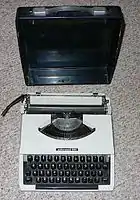 A student's portable underwood 255 manufactured circa 1977 in Japan
A student's portable underwood 255 manufactured circa 1977 in Japan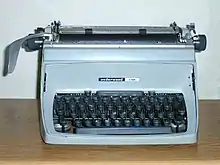 The Underwood Touch-Master 5 was among the last desktop models produced at the Underwood factory in the early 60s
The Underwood Touch-Master 5 was among the last desktop models produced at the Underwood factory in the early 60s Underwood No. 5, in the collection of The Children's Museum of Indianapolis
Underwood No. 5, in the collection of The Children's Museum of Indianapolis
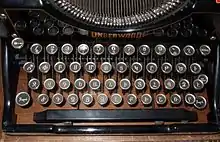 An Underwood typewriter with Armenian letters.
An Underwood typewriter with Armenian letters.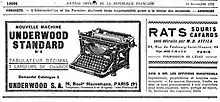 "Underwood standard n° 6" advertisement in France
"Underwood standard n° 6" advertisement in France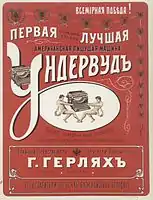 Underwood typewriter advertisement in Russia (1900)
Underwood typewriter advertisement in Russia (1900) typewriter Underwood Portable at the Museum Europäischer Kulturen
typewriter Underwood Portable at the Museum Europäischer Kulturen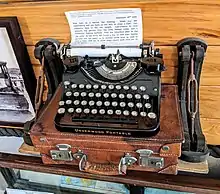 Ernest Hemingway's portable Underwood typewriter
Ernest Hemingway's portable Underwood typewriter Underwood 450, Italian version, detail
Underwood 450, Italian version, detail
References
- "John Wolff's Web Museum – Olivetti Mechanical Calculators".
- Depauw, Karen (November 10, 2014). "Typing History". WNPR.
- George Nichols Engler (1969). The Typewriter Industry: The Impact of a Significant Technological Revolution (PhD dissertation). University of California at Los Angeles. p. 30.
- "West Mountain Historic District". National Park Service. 27 January 1984. p. 13. Retrieved 2013-10-18.
- "Time, monday, Dec. 05, 1927". TIME.com. 5 December 1927.
- Alford, Leon Pratt (1928). Manufacturing Industries. Ahrens Publishing Company. p. 159. Retrieved 2013-10-18.
- McLain, Bill. What Makes Flamingo's Pink. New York, New York, 2001.
-
- The Office. Office Publications. 1945. p. 88.
External links
![]() Media related to Underwood Typewriter Company at Wikimedia Commons
Media related to Underwood Typewriter Company at Wikimedia Commons